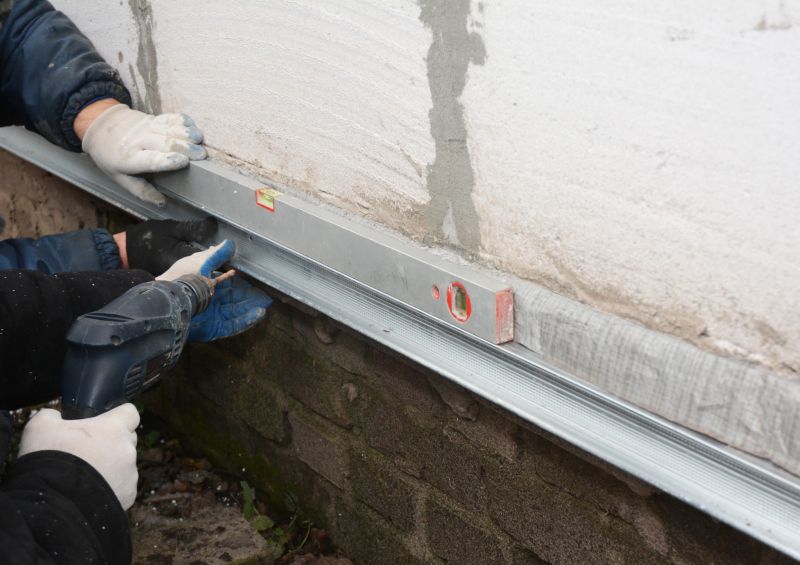Ultimate Guide To Concrete Leveling Products For Homeowners
Find out which products deliver reliable performance and easy application for DIY concrete leveling projects.
 Concrete leveling is an essential process for maintaining the safety, appearance, and functionality of various surfaces around residential and commercial properties. Over time, concrete slabs can settle, crack, or become uneven due to soil movement, moisture changes, or aging. Addressing these issues promptly can help prevent further damage and maintain structural integrity. There are numerous products designed to facilitate effective concrete leveling, ranging from DIY kits to professional-grade solutions. These products typically aim to lift and stabilize uneven slabs, fill cracks, and restore a smooth, level surface.
Concrete leveling is an essential process for maintaining the safety, appearance, and functionality of various surfaces around residential and commercial properties. Over time, concrete slabs can settle, crack, or become uneven due to soil movement, moisture changes, or aging. Addressing these issues promptly can help prevent further damage and maintain structural integrity. There are numerous products designed to facilitate effective concrete leveling, ranging from DIY kits to professional-grade solutions. These products typically aim to lift and stabilize uneven slabs, fill cracks, and restore a smooth, level surface.
Top Overall Option
Polyurethane Foam Concrete Leveling System
Polyurethane foam systems are widely used for their versatility and ease of application. They expand upon injection, lifting and leveling slabs with minimal disturbance to the surrounding area. These systems are suitable for a variety of concrete surfaces and provide a durable, long-lasting solution. Properly installed, they can help stabilize uneven slabs and fill voids effectively, making them a popular choice among professionals and DIY enthusiasts alike.
Types of Products For Concrete Levelings
Polyurethane Foam Kits
Expandable foam systems designed to lift and stabilize slabs with minimal surface disruption.
Concrete Patching Compounds
Ready-mix compounds used to fill cracks and small surface imperfections for a smooth finish.
Mud Jacking Materials
Cement-based slurry used to lift and level sunken concrete slabs.
Epoxy Injection Resins
High-strength resins for crack repair and structural stabilization.
Self-Leveling Underlayments
Materials designed to create a flat, smooth surface for flooring or other finishes.
Polymer-Modified Mortars
Versatile mortars that adhere well and provide durable repairs for cracked or uneven surfaces.
Hydraulic Cement Mixes
Fast-setting cements used for filling and sealing cracks or holes.
Concrete Resurfacing Products
Overlay materials that restore the appearance and surface of worn or damaged concrete.
Injection Grouts
Specialized grouts for stabilizing and filling voids beneath slabs.
Rigid Foam Board Insulation
Insulation panels that can also provide some level of surface leveling when used in repair projects.
Popular Choices
Widely used for their expanding properties and ease of application for various slab repairs.
Commonly used for sealing cracks and preventing further deterioration.
Popular for creating smooth, level surfaces in flooring projects.
Often chosen for raising sunken concrete sections in driveways and sidewalks.
Favored for their ability to lift and stabilize slabs with minimal surface disturbance.
Preferred for structural crack repairs due to its strong adhesion properties.
Popular for renewing worn or stained concrete surfaces.
Commonly used for quick sealing of cracks and holes.
Chosen for fast repairs requiring minimal downtime.
Used for durable surface repairs on cracked or uneven concrete.
Choosing the right product for concrete leveling depends on several factors, including the size and extent of the unevenness, the type of surface, and the desired longevity of the repair. Many products are formulated for easy application, allowing homeowners and contractors to perform repairs with minimal specialized training. Some solutions are versatile enough to be used on driveways, sidewalks, patios, or garage floors, making them suitable for a variety of projects.
When selecting a product, it is important to consider the ease of use, drying or curing times, and the compatibility with existing concrete. Proper surface preparation and following manufacturer instructions are crucial for achieving satisfactory results. Additionally, some products are designed to be more environmentally resistant, offering durability against weather and temperature fluctuations. Investing in quality materials can contribute to a more durable and lasting repair, reducing the need for frequent reapplications.
Overall, the market offers a wide array of options for concrete leveling, from simple patching compounds to advanced polyurethane foam systems. Understanding the specific needs of your project and researching product specifications can help you make an informed decision. Whether tackling a small crack or an extensive uneven surface, the right product can make a significant difference in restoring the safety and appearance of your concrete surfaces.
Key Buying Considerations
- Assess the size and extent of the unevenness or cracks to determine suitable product types.
- Consider whether a DIY solution or professional assistance is needed based on project complexity.
- Check compatibility with existing concrete surfaces and materials.
- Review curing or drying times to plan your project schedule accordingly.
- Evaluate the ease of application, especially if you are a DIY beginner.
- Look for products that provide adequate bonding strength and durability for your climate.
- Determine if the product is suitable for indoor or outdoor use, considering weather resistance.
- Consider the environmental conditions, such as moisture levels and temperature fluctuations.
- Assess the need for additional surface preparation before application.
- Review manufacturer instructions carefully to ensure proper use and safety.
- Compare long-term performance and maintenance requirements.
- Check if the product is compatible with other repair or finishing materials.
- Consider the cost-effectiveness based on the size of the repair area.
- Verify if the product is suitable for structural or cosmetic repairs based on your needs.
- Ensure the product complies with local building codes or regulations if applicable.
